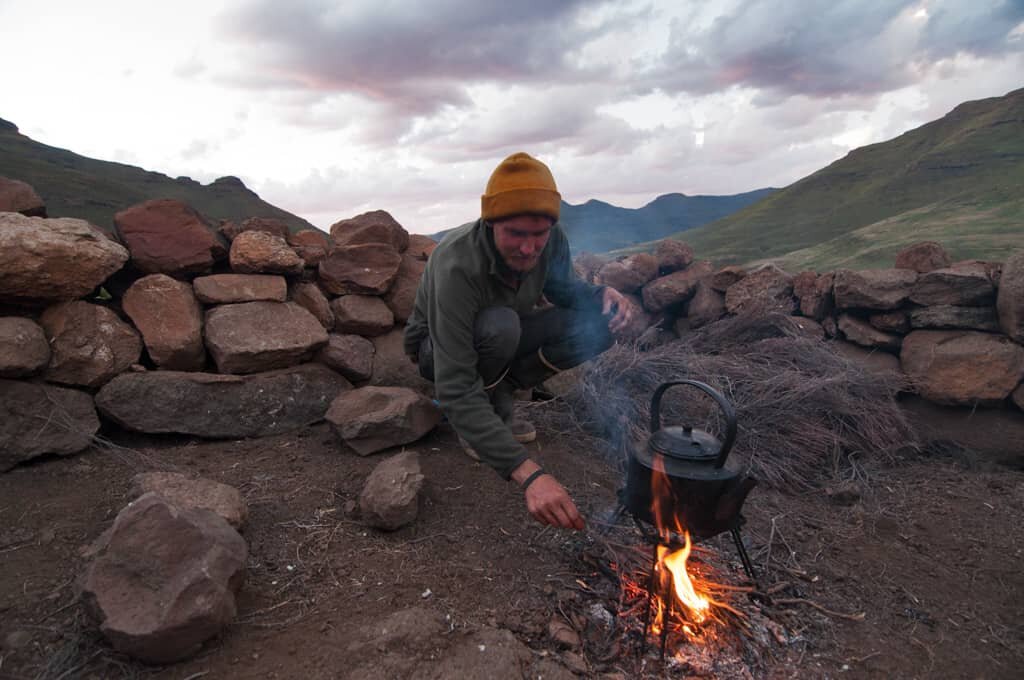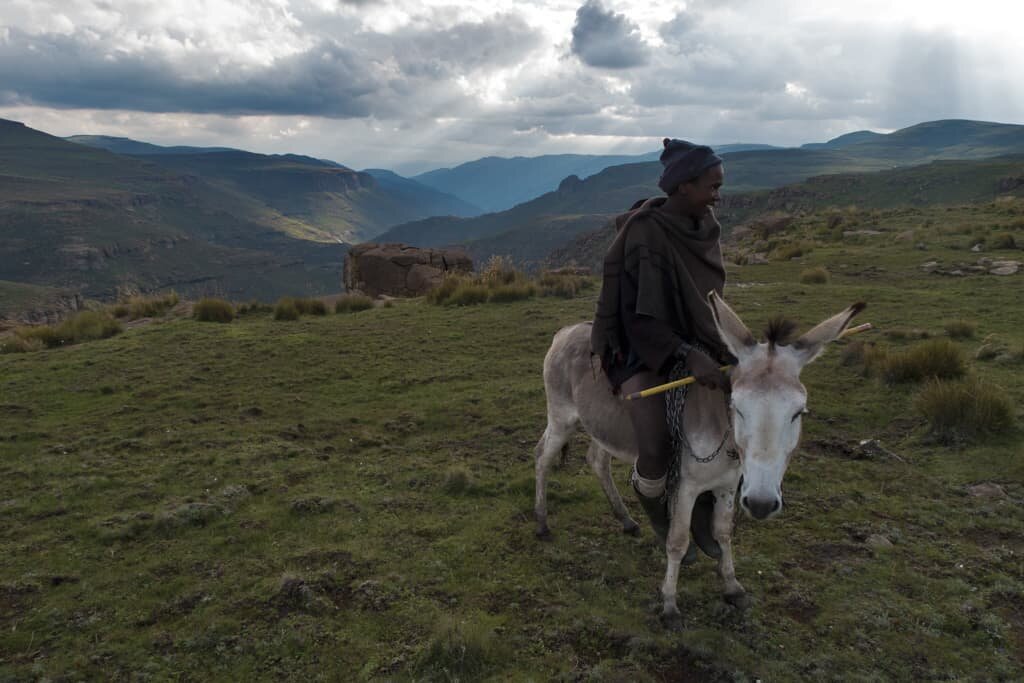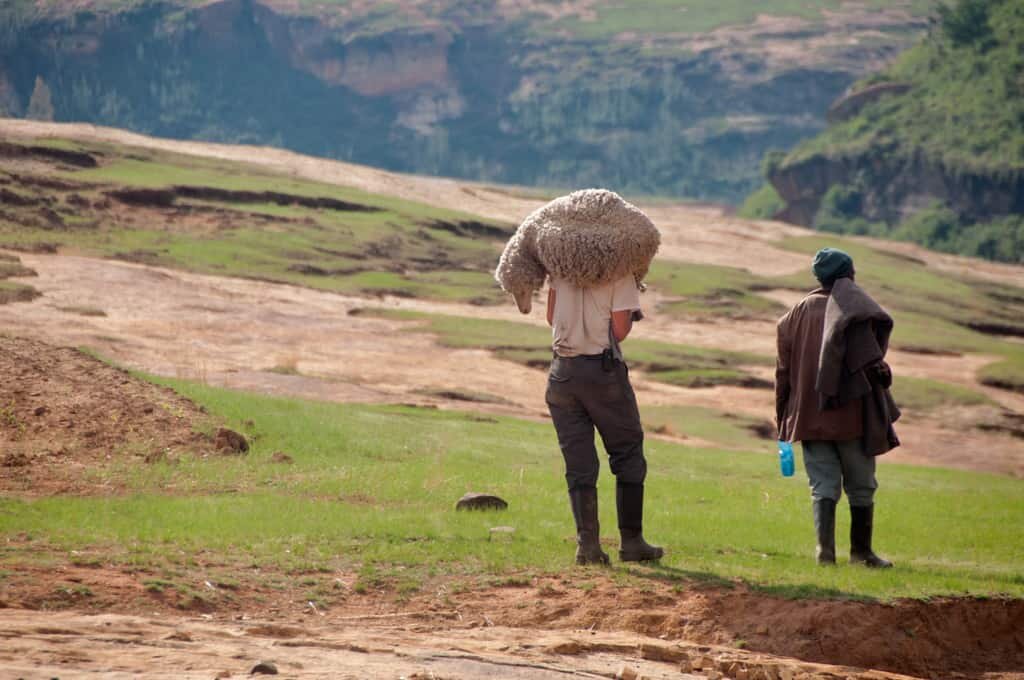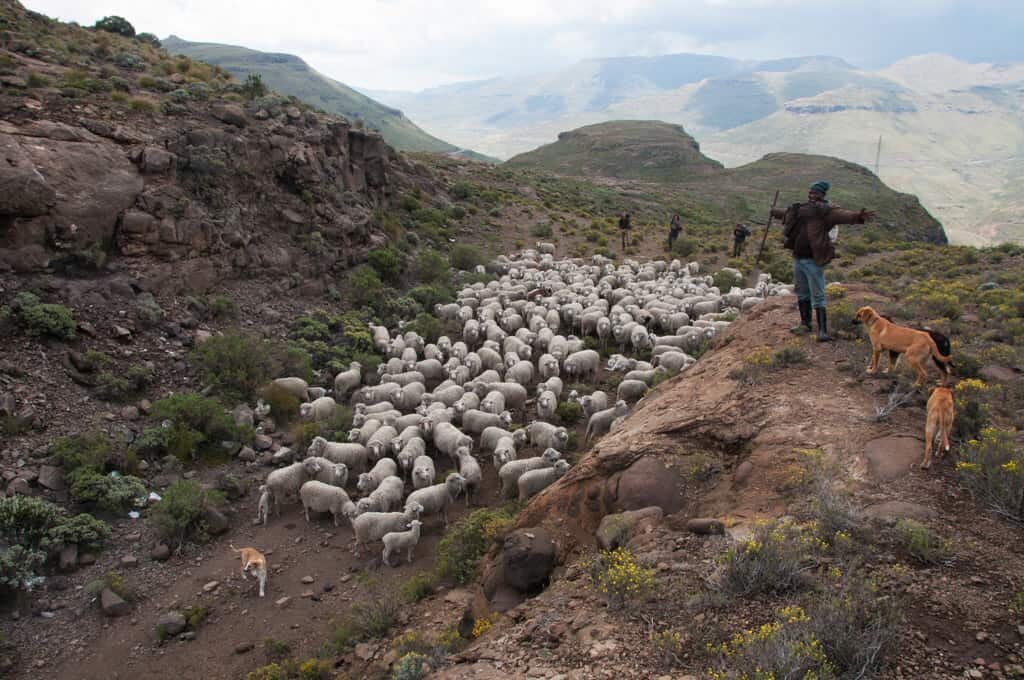Dispatches from a Highland Shepherd
Glimpses of TIMO life in the mountains of Lesotho
At right: Mark’s fellow teammates Caleb, Tobias, Chris, and Spencer along with their shepherd friend, Melofitsani.
by Mark Eekhoff
In October 2014, Africa Inland Mission launched a two-year Training In Ministry Outreach (TIMO) team among the highland shepherds of Lesotho. Team member Mark Eekhoff and his teammates are serving in a unique and challenging location, with the aim to share the Good News with this often-marginalized subculture.
In the treeless expanses of Lesotho’s highlands, rock is the obvious choice for building shelters. Motebongs are small stone and thatch huts long used by Lesotho’s shepherds and now used by the team during their long stays in the mountains.
“After a week of work in the highlands,” Mark reflects, “my hands were converted from those of a Westerner to those a Basotho badisana (shepherd). You can see the toll that moving rocks, cutting thatch grass, and digging beds has taken on them.”
The staple and primary content of the shepherd team’s diet is pap, a maize meal paste, which they eat twice a day. An occasional trout, caught out of mountain streams, provides some much-needed protein.
We all struggle with adjusting to our new diet. The idea of living in constant hunger is a strange one to Westerners, and it is becoming a bit of a struggle. Please pray that the pap and moroho (local herbs) provide the sustenance we need to get through the day.
Mark
A TYPICAL DAY
We get up a 5:30 a.m. and count the sheep and goats to ensure none ran away or were stolen in the night. After that, we gather in one of the huts and cook breakfast, which is now usually just papa and sometimes includes leftover meat, beans, or herbs from the previous night. We finish cooking and eating at 7:00 and head out for the mountaintops. From our hut, we often hike between one and three kilometers to where we plan to graze the animals for the day. This takes anywhere between one and three hours. Once we reach about 10:30, the sheep and goats are tired of walking and lay low for a while. This also gives us the opportunity to sit for a while. During these times, we develop relationships with the shepherds. Sometimes we just take naps.
At about 2:00, we turn the animals around, and they usually know their way home, so it is a matter of walking, sitting, walking, sitting, and walking behind them until we are near the cattle post again. Once we reach 5:00, we go back to our huts and start cooking dinner. At about 6:30, we go out and count the sheep and goats again (we have 142 sheep and 159 goats). After that, it’s almost dark and we gather in one hut or the other to eat our meal and hang out. Then at about 8:00, we bid each other a good night.
One critical piece of equipment for building a motebong and for thatching a roof is a pickaxe. Most shepherds don’t have one, but there are several in the valley which the entire community shares. “When we came,” Mark says, “we brought one of our own, and it has since been used to thatch many roofs. It is such a necessary piece of equipment that when the handle breaks, you need to do whatever you can to get it back into working condition, even if it means taking a piece of poplar branch and turning that into the new handle.”
The life of a shepherd is a simple one, and we hope to assimilate as much as possible. After taking a blanket, boots, staff, and sleeping bag, there is not much space for anything else.
Mark
“Another necessity for properly thatching a motebong roof is rope, and plenty of it,” Mark explains. “While we spent four days building the skeleton of the roof and cutting plenty of grass for the thatching, one shepherd spent almost the entire time just weaving rope, and it still wasn’t enough! This variety is braided from the same grass we use to thatch, and it is incredibly strong. Which is a good thing because it holds our entire hut together.”
“Sheep herding in the highlands is a bit like traveling through airports,” Mark explains. “You hurry to get somewhere so that you can wait there for a while. It provides many wonderful opportunities to read and study throughout the day in some stunning settings!”
GOSPEL RECORDINGS
One primary means the team has for sharing the gospel in this largely orate subculture is through a recorded scripture-based story set prepared prior to the shepherd team’s arrival in Lesotho by AIM missionaries Bekah and Merrill and a team of Basotho shepherds who helped with translation. “We have started to bring our recorded Sesotho Bible Stories to the mountains,” says Mark, “and [the shepherds] are excited to listen to them! When I visited one of the cattle posts, the boys were intently listening to their recorder while preparing breakfast. I hope the words are sinking in!”
“Every night, once the sheep have been rounded up and counted, we spend two to three hours together preparing a fire, cooking, eating, and conversing. On cold and rainy nights, we do this in our motebong; but on warmer, clearer nights, we do so outside and often within the walls of an old roofless motebong. The night sky’s beauty in the highlands is unparalleled. Add wonderful fellowship with Basotho shepherds and co-missionaries, and these nights are truly a highlight."
Mark

















